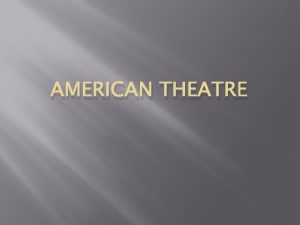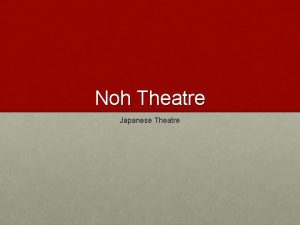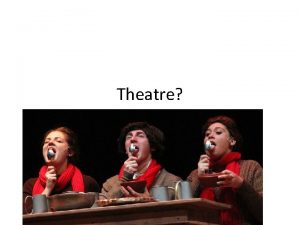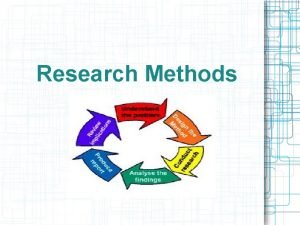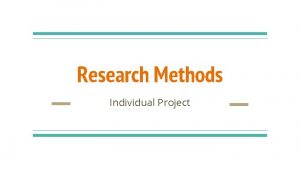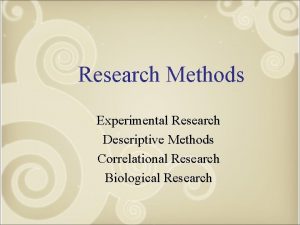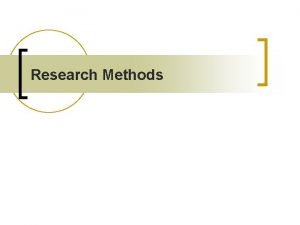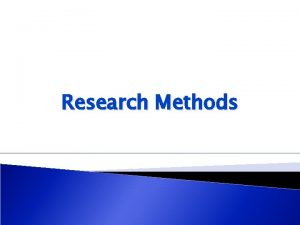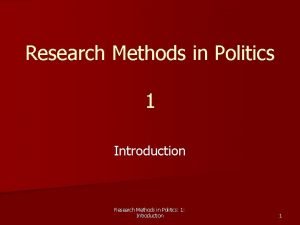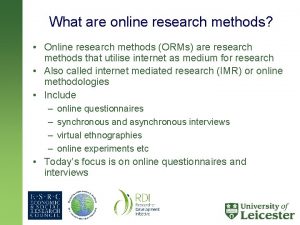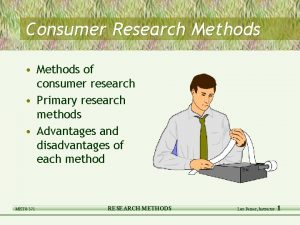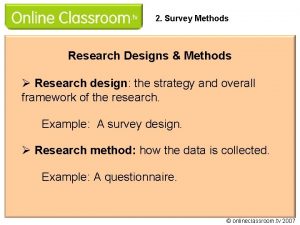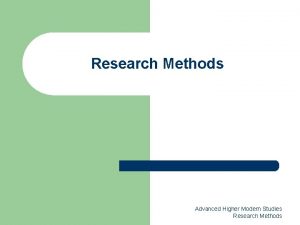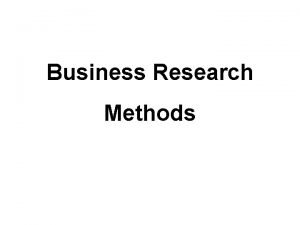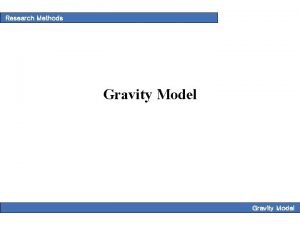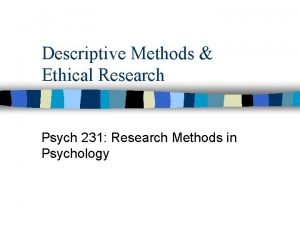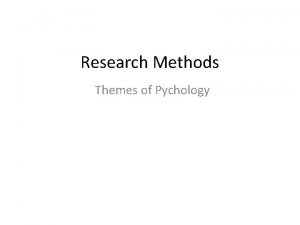Research Methods for the Theatre Department of Theatre

























































































- Slides: 89

Research Methods for the Theatre Department of Theatre and Dance University of Mary Washington

Research Methods I. Developing a research topic and thesis statement II. Forming a search strategy III. Identifying, Locating and Evaluating information sources

Developing a Research Topic • • • A clearly defined research topic is the first step in successful research. Can develop your research topic into a thesis statement. Finding a Research Topic—a tutorial on how to develop a research topic

Research Topic vs. Thesis Statement l Research Topic – l Statement of research subject Thesis Statement – – Completed after research Statement includes research subject, how you are going to prove or disprove your research subject, and brief indication of findings.

Research Topic vs. Thesis Statement l l For a fashion history paper (Can you identify the difference? ) Topic Statement: – l Within the institution of slavery in America from 1770 -1865 there existed a social hierarchy among slaves manifest in the different quality of clothing of each caste. Thesis Statement: – Within the institution of slavery in America from 1770 -1865 there existed a social hierarchy among slaves manifest in the different quality of clothing of each caste. An investigation of the clothing worn by slaves at the Ballyman Plantation illustrates each segment of the social hierarchy, suggesting a sartorial rigidity as defined as those of the plantations non-slaves.

Research Topic vs. Thesis Statement l l For a fashion history paper Topic Statement: – l At the end of the 18 th century in Europe, the foppish style of the effeminate Macaronis fell out of favor as men like Beau Brummell standardized a new style, commonly known as ‘dandyism’, which primarily focused on the art of dressing impeccably. Thesis Statement: – At the end of the 18 th century in Europe, the foppish style of the effeminate Macaronis fell out of favor as men like Beau Brummell standardized a new style, commonly known as ‘dandyism’, which primarily focused on the art of dressing impeccably. This paper examines the history of the English and French 19 th century dandy with a particular emphasis upon how they dramatically altered fashion while challenging the concepts of male vanity and social class. , ultimately leading to a new definition of masculinity.

The Assignments: 1: Write a research paper on some aspect of contemporary theatre. 2: Complete a character analysis of Emma Goldman. 3: Design scenery, lights and costumes for The Game of Love and Chance by Marivaux.

I. Developing a Research Topic: Defining a specific research question & research topic

Assignment # 1: Write a research paper on some aspect of contemporary theatre. l Need idea of what information is available before you write. – Broad topic, too many options l l – Narrow topic, too few options l l Difficult to find relevant sources if topic is broad/ambiguous What if there is nothing new to say? What if you choose a topic with no information? Literature Review?

What is a Literature Review? l Generally, the purpose of a literature review is to analyze critically a segment of a published body of knowledge through summary, classification, and comparison of prior research studies, other literature reviews, and theoretical articles. – “Review of Literature. ” The Writer’s Handbook. The Writing Center, UW at Madison. 2004, 15 Feburary 2006 <http: //www. wisc. edu/writing/Handbook/ Reviewof. Literature. html>. Path: Home; Writers Handbook; Common Writing Assignments; Review of Literature. How to construct a Literature Review (http: //writingcenter. unc. edu/handouts/literature-reviews/)

Literature Review--Example • The next slide is the introduction and literature review for a paper on queer readings of musical theatre. • The second paragraph—the literature review—briefly and clearly explains the findings of previous studies of the same or similar subjects. • Examples from the paper: “You’ve got that thing”: Cole Porter, Stephen Sondheim, and the Erotics of the List Song. Theatre Journal. 64 (2). December 2012.

Literature Review—Example First Paragraph--Introduction The ascendance of queer theory effected a sea change in theatre studies and musicology. Beginning in the 1990 s, scholars in both disciplines started using its methods to study the histories of theatre and music, paying particular attention to those writers, composers, and performers most likely to have savored homoerotic fantasies and practices and to those genres most associated with lesbian or gay subcultures. Music theatre has been especially alluring to queer theorists and historians, in part because of the adulatory cults that have developed around opera and the Broadway musical. Indeed, the opera queen and the musical theatre queen are routinely imagined to be the most visible and fervent of fans. From Philadelphia to Smash, gay men can be pinpointed by their adoration of Maria Callas or Ethel Merman. Despite this preponderance of queer devotees, however, the assignment of sexual provenance to either genre is problematic. As Judith Peraino notes: “Music is notoriously resistant to legibility, ” especially in regard to sexuality, and even music theatre, complete with text, plot, and characters, defies sexual classification.

Literature Review—Example Second Paragraph—Literature Review Music theatre’s resistance to classification has not stopped a number of critics since the 1980 s from claiming the Broadway musical as a gay theatrical genre, albeit one that has been closeted for most of its history. Gerald Mast, for example, writing in 1987, epitomizes post-Stonewall, gay-positive criticism by noting the attraction of “gay people” to the musical’s “masquerade of extravagant excess and outrageous frippery. ” Believing that both musicals and “gay people” practice a subversive double-coding, he argues that musicals “translate their alternative vision of human and social relationships into forms that both disguise it as societal critique and allow its implications to be clearly read. ” • • This sentence is the ultimate finding of the literature review This and the following entries in blue, summarize the history of scholarship supporting the ultimate finding of the review.

Literature Review—Example Second Paragraph—Literature Review John Clum elaborates a similar approach a decade later while making even more sweeping claims: “Musicals were always gay. ” Having absorbed the lessons of queer theory about the intractability of sexual desires and identities, D. A. Miller and Stacy Wolf develop more nuanced, circumspect, and historically specific arguments. Miller’s Place for Us is a theoretical tract cum memoir that mines his own experience to argue that musicals—especially Gypsy (1959), his master text—represent privileged sites for gay men to rehearse and perform their identifications and desires. Wolf, meanwhile, in A Problem Like Maria and Changed for Good, offers both a provocative lesbian reading of the musical and a much-needed feminist history of the form.

My assignment says to write an abstract of my paper—What is it? • An abstract is a self-contained, short, and powerful statement that describes a larger work. • Components vary according to discipline. • An abstract of a humanities work may contain thesis, background, and conclusion of the larger work. • An abstract is not a review, nor does it evaluate the work being abstracted. • While it contains key words found in the larger work, the abstract is an original document rather than an excerpted passage. • UNC Writing Center—https: //http: //writingcenter. unc. edu/? s=abstract

Abstract—Example Critics have long noted the association between the Broadway musical and gay men as both producers and consumers. But rather than claim that musicals are gay, lesbian, or queer, this essay analyzes the circulation of desire in the work of two composer-lyricists, Cole Porter and Stephen Sondheim, by focusing on their mastery of the list or catalog song, a form that requires only that its lyric contains an inventory of people, places, or things. The essay argues that the list song functions as a kind of desiring-machine, an assembly line of words that represents a musical consequence and signature of the Fordist means of production. The list songs of Porter and Sondheim, which herald the beginning and end of Broadway’s so-called Golden Age, divulge in their differing ways the contrasting sets of desires and anxieties that swirl around the closet—and the Broadway musical—in the decades before and after the Stonewall riots.

Assignment # 1: Write a research paper on some aspect of contemporary theatre. l Research Question: How did American theatre and theatre artists respond to the events of 9 -11? Were any plays written that dealt with the events? If so, what were themes of those plays?

Assignment #2: Complete a character analysis of Emma Goldman. l Research Question: Research and write a complete, detailed biographical study of Emma Goldman relative to developing her as a character for the play Emma by Howard Zinn.

Assignment #3: Design scenery, lights and costumes for The Game of Love and Chance. l Research Question: Complete an analysis of 18 th century French style in order to design costumes, lights, and scenery for The Game of Love and Chance.

Integrity: Inspired by. . or. . Copy of… l l http: //www. playbill. com/news/article/mantelloand-caldwell-theatre-settle-lvc-case-issuesstill-unresolved-81475 Plagiarism in Theatre

Integrity: Inspired by. . or. . Copy of… l l Needs of script and be challenging Understand what you respond to in the inspiration-an idea? a specific image? Don’t look Just too many choices to copy

Integrity: Common Types of Plagiarism l l l Direct: word for word Self: using your work again without credit Mosaic: borrowing phrases without quotes and changing words with synonyms Accidental: neglecting to cite sources without intent Structure: similar organization of ideas and argument

Integrity: Common Types of Plagiarism Tutorial

II. Determine a Search Strategy How will you search to find the information you are looking for?

Determining a Search Strategy l l l Identify subject and key concepts for your search topic Identify potential information sources Identify where those information sources are located in the library, and how to use them

Determining a search strategy: Identify subject and key concepts for topic l l Purpose Subject Area • Focus • Topic l Topic • Concepts • Subject & Key Word

How did American theatre and theatre artists respond to the events of 9 -11? Were any plays written that dealt with the events? If so, what were themes of those plays? l l Purpose: Scholarly research paper Subject: 21 st century theatre history Focus: American theatre after 9 -11 Topic: How did American theatre respond to the events of 9 -11. l Concepts: • Theater/re, response to 9/11 l Subject & Key Words: • Theatre: plays, drama, theatre • Response: reactions • 9 -11: terrorism

Research and write a complete, detailed biographical study of Emma Goldman relative to developing her as a character in the play Emma by Howard Zinn. l l Purpose: Scholarly research paper. Subject: Emma Goldman Focus: Biographical Study Topic: Life, times, and beliefs of Emma Goldman. l Concepts: • Emma Goldman, Biographical information l Subject & Key Words: • Goldman: anarchist, suffraget • Biographical information: life, death

Complete an analysis of 18 th century French style in order to design costumes, lights, and scenery for She Stoops to Conquer. l l Purpose: Scholarly research for design. Subject: 18 th C. France. Focus: Period style Topic: What were the architecture, décor, dress, and art of the 18 th c France? l l Concepts: • 18 th c French architecture, décor, dress, art, history. Subject & Key Words: • 18 th c: eighteenth century, Rococo • Dress: Clothes, costume. • Art: Painting, sculpture • Architecture: Domestic, Religious, Versailles • Décor: Interior decoration • History: Government

Determining a search strategy: Identify potential information sources l Research needs determine which information sources to search!

Identifying Potential Source Options l Subject & Related subject areas – l l Subject Librarian--Subject Areas Source Content & Level Source Scope Identification of possible sources Search strategy

Identifying Potential Source Options l Source Content: – – Scholarly—those created by persons taking a scholarly approach to the subject. Popular—those created by persons taking a non-scholarly approach to the subject. l l Criteria to tell the difference Source Level: – – Primary—generally, those created at the time of the event or person’s life that you are studying. Secondary—generally, those created after the time of the event of the person’s life that you are studying. l Criteria to tell the difference

Assignment #1: l Principal Subject Area: – Humanities l l l Theatre Related Subject Area: Source Content: – – 1 st Choice: Scholarly—need analytical opinions from theatre scholars. 2 nd Choice: Popular—may provide reviews of plays and opinions as to their value, or the plays from the audience’s point of view.

Assignment #1 l Source Level: – – l Primary: necessary because they will capture the immediate response of theatre community. Secondary: necessary because they will evaluate, compare and analyze theatre of the event. Source Scope: – Comprehensive and specialized sources are acceptable.

Assignment #1 l Source Identification: – 1 st Choice: Periodicals will be best for primary sources as most will still be available in electronic indexes. It will be best source for theatre periodicals (scholarly), and it will also have human interest stories (popular) in papers like the New York Times. l l l Carlson, M. “ 9/11, Afghanistan, and Iraq: The Response of the New York Theatre”. Theatre Survey, May 2004. Cameron, B. “When 9/11 is History”. Theatre Survey, September, 2002. Salmon, J. “A Response to 9/11, So Unheroically Human”. New York Times, December 15, 2002.

Assignment #1 l Source Identification: – – – 2 nd Choice: Books will be helpful, particularly if they are a compilation of articles on the subject or books written about the subject. (Too early for them to have been written? ) Play Scripts written about the events of 9/11 will give insight into theatre’s response. l Mueller, L. Voices from September 11 th. l Thomas, A. & Batra, T. With their Eyes: September 11 th—the View from a High School at Ground Zero. l La. Bute, N. The Mercy Seat.

Assignment #1 l Search Strategy: – Begin with a general search of journal databases looking for scholarly and popular articles with a subject of theatre and 9/11. Then move to see if there any books or plays that have been written about the topic specifically, or that hold essays on the subject.

Assignment #1 l l l Research Question: How did American theatre and theatre artists respond to the events of 9 -11? Were any plays written that dealt with the events? If so, what were themes of those plays? Research Topic: The events of 9/11 had both an immediate and lasting affect on American theatre, not only in New York City and Washington, DC, but across the country. Thesis Statement: A study of American theatre from September 11, 2001 to September 11, 2009, shows the affects of the 9/11 events on theatre. While an immediate, visceral theatrical response appeared in New York City, but waned after a few months, an investigation of new plays written since the attack, shows a more lasting affect in both plays dealing specifically with the tragedy, and plays with subject matter informed by the 9/11 events.

Assignment #2 l Principal Subject Area: – Humanities l l Related Subject Area: – Social Sciences l l l History Women’s studies Political science Source Content: – – 1 st Choice: Scholarly—need biographical sources explaining her place as an anarchist, feminist, and social activist. 2 nd Choice: Popular—look in contemporary periodicals for articles written about her.

Assignment #2 l Source Level: – – l Secondary—Contemporary authors who have written about her will be most prevelant. Primary—Did she write an autobiography? Is there an annotated autobiography? Popular news sources written during her lifetime? Source Scope: – Comprehensive and specialized are acceptable: l Comprehensive: – l Marsh, M. Anarchist Women, 1870 -1920. Specialized: – – Goldman, E. Living My Life. Wexler, A. Emma Goldman: An Intimate Life.

Assignment #2 l Source Identification: – – – Books--as she is a historical figure most of the information about her will be in books. Periodicals--there may be articles written about her in contemporary publications as well as copies of primary articles. Reference Materials--because she was a historical figure she will be in most encyclopedias, general and subject. l The Encyclopedia of Women in American History

Assignment #2 l Search Strategy: – Begin with biographies of Goldman as well as her autobiographical writings. Then move to books and periodicals that write about her place as an anarchist, woman, and social activist.

Assignment #3 l Principal Subject Area: – Humanities l l l Related Subject Area: – Social Sciences l l Art History Architecture Anthropology (Costume & Dress) Source Content: – – 1 st Choice: Scholarly—need sources that explain & analyze 18 th century French style. 2 nd Choice: Popular—photographs in periodicals (Architectural Digest)

Assignment #3 l Source Level: – – l Secondary: authors who have written about 18 th century style, after the 18 th century will be most prevalent. Primary: those who wrote about the 18 th century while living in it (diaries/letters); also paintings of architecture and dress. Source Scope: – Comprehensive and specialized sources are acceptable. l Comprehensive: – Ribero, A. Dress in Eighteenth-Century Europe. – Summerston, J. The Architecture of the Eighteenth Century. l Specialized: – Delpierre, M. Dress in France in the Eighteenth Century. – Kalnein, W. Architecture in France in the Eighteenth Century.

Assignment #3 l Source Identification: – – Books most of the material will be in books. Periodicals l l – Scholarly journals such as Dress and Eighteenth Century Studies. Popular periodicals such as National Geographic Reference Materials some reference sources may have articles on famous people, architecture, and behaviors of the period. l “Rococo” in Encyclopedia of Interior Design l “Rococo Style” in Encyclopedia Americana

Assignment #3 l Search Strategy: – Begin with general, comprehensive secondary sources that describe elements of 18 th century style. Then look for specialized secondary sources covering specific aspects of the same period. Look for visual images that define the period.

End Part I & II I. Develop a research topic II. Form a search strategy

III. Identifying, Locating & Evaluating information materials -What specific type of source has the information? -Where it is located in the library? -Authority of information source?

Identifying, Locating & Evaluating information materials Identifying different types of information sources in the Simpson Library Which type is most likely to have the information that I want?

Types of information materials available in the Simpson Library l Reference Sources Books Periodicals Databases l All are accessible via the Library Web l l l – The CONTENTS of each may not be electronically available

Reference Sources l l l l Encyclopedias Dictionaries & Thesauri Almanacs Yearbooks Handbooks Atlases Indexes

Encyclopedias l Encyclopedias contain brief overview articles on a wide range of subjects. Encyclopedias are frequently sets of multiple volumes and may cover a broad range of subjects or focus on a single subject area. – – General: Encyclopaedia Britannica, Britannica Online Subject: Mc. Graw-Hill Encyclopedia of World Drama

Subject Encyclopedias l l l Assignment #1: -The Oxford Encyclopedia of Theatre & Performance -Critical Survey of Drama -Drama Criticism Assignment #2: -Encyclopedia of Women Social Reformers -Activists, Rebels, and Reformers -Women in World History Assignment #3: -The Encyclopedia of Clothing and Fashion -Encyclopedia of Interior Design -The Dictionary of Art

Dictionaries & Thesauri l Dictionaries & Thesauri provide definitions of words and phrases. Some include the origins and histories of terms. Some include general terms in a particular language, whereas others may define jargon in a particular field of study. – – – Language dictionaries provide definitions for words in multiple languages. Biographical dictionaries give information about people's lives and accomplishments. Thesauri identify other words or terms with the same or similar meaning.

Dictionaries & Thesauri l Assignment #1: – l Assignment #2: – l International Dictionary of Theatre: Plays Larousse Dictionary of Women Assignment #3: – Illustrated Dictionary of Historic Architecture

Almanacs & Statistical Sources l l Almanacs are compilations of facts and statistics and in the case of Theatre research can be useful to look up statistics related to the arts. Most almanacs are updated annually or according to another regular schedule. Statistical Sources just include compilations and summaries of numeric data.

Almanacs & Statistical Sources l Almanac: – l World Almanac and Book of Facts Statistical Source: – – Lexis. Nexis Statistical Abstract of the United States: 2004 -2005 l l – Statistics available: Theatre Attendance and Receipts; Federal aid to theatres; personal expenditures on theatre. Available electronically http: //www. census. gov/library/publications/timeseries/statistical_abstracts. html

Yearbooks l Yearbooks provide annual updates of current events, facts, statistics, new discoveries, research or other timely information. Some reference book publishers issue yearbooks to update and supplement their publications until a new editions are available.

Handbooks, Manuels & Guides l Handbooks, manuals, and guides to a field of study provide a detailed overview of or a general introduction to a subject area. – – – Handbooks are similar to encyclopedias only with more in -depth entries. Manuals provide instruction on how to do something. Guides to a field of study are designed to teach researchers or students about the sources and research methodology in the field.

Atlases, Gazetteers & Guidebooks l Atlases, Gazetteers and Guidebooks are geographical sources. – – – Atlases are composed primarily of maps but may contain additional geographic information. Gazetteers are dictionaries of place names and landmarks, both natural and man-made. Guidebooks give important travel and other descriptive information about places

Indexes, Abstracts & Bibliographies l l Indexes, abstracts and bibliographies provide access to books, the contents of periodicals (magazines and journals), research reports, chapters in books, dissertations, and other materials. The majority of people use these types of sources to locate periodical articles on a particular topic.

Indexes, Abstracts & Bibliographies l Indexes are alphabetical subject-based listings of items. – Periodical Index (database) l Author and Title and Subject access points – – A single item may be listed under several subject headings. Index in a Book l Includes the content of that book only l Abstracts are indexes that include summaries of the contents of the listed materials. These summaries are called abstracts as well. l -Bibliographies are compilations of sources on a particular topic, by a particular author or in a particular library collection. – Subject Bibliography l l – Author, Title, and broad Subject access points. Unlike an index, entries usually appear once. Bibliography in a book l l List of sources used to write that book To find other sources on same topic

Indexes, Abstracts & Bibliographies l Assignment #1: – – l Assignment #2: – – l Index: Expanded Academic ASAP Bibliography: American Theatre History: An Annotated Bibliography. Index: Expanded Academic ASAP Bibliography: Anarchist Thinkers and Thought: An Annotated Bibliography. Assignment #3: – – Index: Expanded Academic ASAP Bibliography: Architecture: A Bibliographic Guide to Basic Reference Works, Histories, and Handbooks.

Books l Generally, scholarly books (as opposed to fiction) are either written on a single topic or are a collection of many articles, written by one or more authors on a single subject. – l A collection of essays on a subject might be as helpful as a single topic book, as it will often give different perspectives on the same topic in one place Books are shelved by subject. That means that books with a similar subject should be next to each other on the shelves. – However, this may not always be the case, so if you do not find more than one book on the same subject, do not assume that there are no more, as they just may be shelved in another place—under another subject.

Books l Assignment #1: – l Assignment #2: – – l None available Solomon, M. Emma Goldman Watson, M. Lives of Their Own: Rhetorical Dimensions of Autobiographies of Women Activists. Assignment #3: – – De. Lorme, E. Garden Pavillions and the 18 th Century French Court. Adams, Censer & Graham. Visions and Revisions of Eighteenth-Century France.

Periodicals l Journals and magazines are periodicals. This means that they are published at regular intervals. Both are numbered in volumes which correspond to a specific year and most journals have issue numbers. – – A Journal is a scholarly publication in which researchers report findings of studies relative to a specific field. Most journal articles are evaluated by a panel (jury) of experts for accuracy and relevance before being published. Magazines are written by a staff of writers for a more “popular” audience and the articles are not evaluated by a jury. There are Magazines and Journals covering most disciplines. l How do you tell the difference?

Periodicals l Theatre Journals – – – Theatre Journal Modern Drama Theatre Topics Theatre Survey Women in Performance l Theatre Magazines – – American Theatre Magazine Live Design Shakespeare Magazine TD&T

Assignment #1 l Journal: – l Gomez-Pena, E-Mael, & Mc. Kee. “Re: Group/No homeland: A Post-9/11 Intercultural Poltergeist. ” TDR, 47(4), 2003. Magazine: – Shandell, J. “Authors!”. American Theatre, 22(3), 2005.

Assignment #2 l Journal: – l Falk, C. “Emma Goldman: Passion, Politics, and the Theatrics of Free Expression”. Women’s History Review, 11(1), 2002. Magazine: – Auleta, B, Goldstone, B. “Happy Birthday, Emma”. Off our Backs: A Women’s Newsjournal. 1, 1970

Assignment #3 l Journal: – l Riberio, A. “The Art of Dress, Fashion in England France 1750 -1820”. Eighteenth Century Studies, 29(4), 1996. Magazine: – Rosenau, H. “Functional & the Ideal in late Eighteenth-Century French Architecture”. The Architectural Review, 140, 1966.

Databases l l Free & Subscription Free databases are those that anyone can access. – – Most of the databases available on the web are free. Be sure to check the authority of the information. l Records of Early English Drama

Databases l Subscription databases are those that you can only access for a fee, in this case paid by the University. l Databases are differentiated by – Subject scope – Citation, Abstract, &/or Full-Text

Subscription Databases l l Broad Scope--Arts and Humanities Search Narrow Scope--Art. Stor: Decorative Arts or Fashion – l Use advanced search Most of the information in these databases is compiled from other sources by editors. – Basic search and an Advanced search option l The basic search is usually just a “keyword” search. The advanced search allows very specific searches using different search terms.

Subscription Databases l Broad – – – l Art Full Text NYPL Digital Gallery Project Muse Narrow – – ARTStor Civil War: A Newspaper Perspective English Verse Drama Harp Week l Find these here

Subscription Databases l Citation, Abstract, &/or Full-Text Indexes – A Citation Index only gives you the information you need to locate an article: the title, author, publication, and date. Some Citation Index’s also include: l An Abstract which is a short synopsis of the article. – A Full-Text Index gives you the citation along with the complete text of the article as it was originally published. – Databases may be any combination of the three.

Subscription Databases l Citation DRESS IN 18 TH-CENTURY EUROPE, 1715 -1789 - RIBEIRO, A Author: KORSHIN, PJ Source: EIGHTEENTH-CENTURY STUDIES 21, no. 1 (FAL 1987): 147 -151 Abstract – DRESS IN 18 TH-CENTURY EUROPE, 1715 -1789 - RIBEIRO, A. Author: KORSHIN, PJ Source: EIGHTEENTH-CENTURY STUDIES 21, no. 1 (FAL 1987): 147 -151. (Book Review) Riberio’s thesis for her new book is “ clothes played the most vital role in defining man and his part in society, to an extent which we cannot contemplate today”. The book is a development of this theme by investigation dress, social factors for dress, and the heavy influence of French Court society on clothing. – l l Full Text – Provide full text copy of the article with citation.

Subscription Databases l l l Arts and Humanities Search Expanded Academic ASAP Humanities Abstracts Humanities & Social Sciences Index Retrospective: 1907 -1984 Literature Resource Center. LCR Project Muse l Citation Full-Text, Abstract, Citation, Abstract l Citation, Abstract, Full-Text l l l

Subscription Databases l How do I find which databases we have? – Simpson Library Home Page

Identifying, Locating & Evaluating information materials Finding materials in the Simpson Library. UMWLib. Guides

Identifying, Locating & Evaluating information materials l l Finding different sources in the library l using Simpson Library Web Page l While you can find all materials electronically using the web page, you may not be able to access the content of all materials electronically. Finding different sources outside the library l l l Use the World. Cat database Google Scholar Item you want not in the library? Try an Interlibrary Loan Request. (Remember: no guarentee of arrival time)

Reference Sources & Books l Use the library web page to locate Reference Sources and Books by title, subject, or author. – – – l The catalog will not search the text in either source. E Books -Naxos Music/Video Library OED When you find one book that you like, try finding others like it by clicking on one of the “subject” links in the book’s record.

Periodicals l Use the databases link from the Library web page to access a full-text or citation database to locate articles in Periodicals. – When you find the title of an article that you want, there may be a “locate journal article” link in the citation will let you see if the library has a copy of the article available for you. l – The library does not have access to all the periodicals included in every database. When you find one article that you like, you can also click on a “subject” link for related articles. Even though each database calls the subject links something else, they all provide that option to search for related articles that way.

Databases l Use the databases link from the library web page to find information in a Database, go to that database and use the search tools provided. – – Almost all subscription databases default to a keyword search that searches the title, text, and subjects of the entry. You may also be able to click on a “subject” link for related articles. Not all databases use the same search techniques. If you are having trouble finding information in a specific database, then look for a help box that will explain how to search the specific database using an advanced search. OR see a Reference Librarian.

Identifying, Locating & Evaluating information materials Determining which information sources are acceptable for your research. – – Generally an academic library chooses authoritative sources offering contrasting opinions YOU SHOULD NEVER ASSUME AUTHORITY

Identifying, Locating & Evaluating information materials l Evaluation of source materials – Generic Criteria for Evaluation l l Stated Criteria for inclusion of information Authority of author(s) Comparability with related sources Stability of information – Edited from: Tilliman, Hope N. “Generic Criteria for Evaluation. ” Evaluating Quailty on the Net. March 28, 2004. <http: //www. hopetillman. com/findqual. html>.

Evaluating information: Print l Criteria – l Authority – l What qualifications merit the author as a source? Why is their opinion valid? Comparability – – l The author should tell you why they included and excluded what they did. How does their scholarship compare to the total written on the subject? Are they writing with a bias? Stability – Is what they are writing based on established research methods?

Evaluating information: Web Sites l l Five criteria for evaluating Web pages USC-Chico guide to evaluate information sources – – – Accuracy Authority Objectivity Currency Coverage

Evaluating information: Web Sites l Acceptable – – – British Drama Federal Theatre Project Costume Clothing of the 18 th Century The Emma Goldman Papers l Questionable – – – Kabuki Theatre Burlesque Theatre. History. com Historical Boys Clothing Goldman Archive

Further Questions? l l l Research Resources by Subject--Simpson Library (Click on Guides) Reference Librarians and subject areas Internet Public Library Purdue University's Online Writing Lab UMW - Writing Center UNC-Writing Center l Presentation updated 9/9/16
 Direct wax pattern technique
Direct wax pattern technique Kontinuitetshantering i praktiken
Kontinuitetshantering i praktiken Novell typiska drag
Novell typiska drag Tack för att ni lyssnade bild
Tack för att ni lyssnade bild Ekologiskt fotavtryck
Ekologiskt fotavtryck Shingelfrisyren
Shingelfrisyren En lathund för arbete med kontinuitetshantering
En lathund för arbete med kontinuitetshantering Kassaregister ideell förening
Kassaregister ideell förening Personlig tidbok fylla i
Personlig tidbok fylla i Sura för anatom
Sura för anatom Densitet vatten
Densitet vatten Datorkunskap för nybörjare
Datorkunskap för nybörjare Tack för att ni lyssnade bild
Tack för att ni lyssnade bild Tes debattartikel
Tes debattartikel För och nackdelar med firo
För och nackdelar med firo Nyckelkompetenser för livslångt lärande
Nyckelkompetenser för livslångt lärande Påbyggnader för flakfordon
Påbyggnader för flakfordon Vätsketryck formel
Vätsketryck formel Offentlig förvaltning
Offentlig förvaltning I gullregnens månad
I gullregnens månad Presentera för publik crossboss
Presentera för publik crossboss Jiddisch
Jiddisch Kanaans land
Kanaans land Klassificeringsstruktur för kommunala verksamheter
Klassificeringsstruktur för kommunala verksamheter Luftstrupen för medicinare
Luftstrupen för medicinare Claes martinsson
Claes martinsson Cks
Cks Byggprocessen steg för steg
Byggprocessen steg för steg Mat för unga idrottare
Mat för unga idrottare Verktyg för automatisering av utbetalningar
Verktyg för automatisering av utbetalningar Rutin för avvikelsehantering
Rutin för avvikelsehantering Smärtskolan kunskap för livet
Smärtskolan kunskap för livet Ministerstyre för och nackdelar
Ministerstyre för och nackdelar Tack för att ni har lyssnat
Tack för att ni har lyssnat Referat mall
Referat mall Redogör för vad psykologi är
Redogör för vad psykologi är Borstål, egenskaper
Borstål, egenskaper Tack för att ni har lyssnat
Tack för att ni har lyssnat Borra hål för knoppar
Borra hål för knoppar Vilken grundregel finns det för tronföljden i sverige?
Vilken grundregel finns det för tronföljden i sverige? Standardavvikelse
Standardavvikelse Tack för att ni har lyssnat
Tack för att ni har lyssnat Steg för steg rita
Steg för steg rita Ledningssystem för verksamhetsinformation
Ledningssystem för verksamhetsinformation Tobinskatten för och nackdelar
Tobinskatten för och nackdelar Blomman för dagen drog
Blomman för dagen drog Mästar lärling modellen
Mästar lärling modellen Egg för emanuel
Egg för emanuel Elektronik för barn
Elektronik för barn Antikt plagg
Antikt plagg Strategi för svensk viltförvaltning
Strategi för svensk viltförvaltning Kung dog 1611
Kung dog 1611 Indikation för kejsarsnitt på moderns önskan
Indikation för kejsarsnitt på moderns önskan Sju för caesar
Sju för caesar Tack för att ni lyssnade
Tack för att ni lyssnade Vilka tal pekar pilarna på
Vilka tal pekar pilarna på Rim texter
Rim texter Inköpsprocessen steg för steg
Inköpsprocessen steg för steg Fuktmätningar i betong enlig rbk
Fuktmätningar i betong enlig rbk Ledarskapsteorier
Ledarskapsteorier Skivepiteldysplasi
Skivepiteldysplasi Myndigheten för delaktighet
Myndigheten för delaktighet Frgar
Frgar Tillitsbaserad ledning
Tillitsbaserad ledning Läkarutlåtande för livränta
Läkarutlåtande för livränta Tät skog karttecken
Tät skog karttecken Lek med former i förskolan
Lek med former i förskolan Shivaismen
Shivaismen Mitos steg
Mitos steg Bris för vuxna
Bris för vuxna Jätte råtta
Jätte råtta Hình ảnh bộ gõ cơ thể búng tay
Hình ảnh bộ gõ cơ thể búng tay Bổ thể
Bổ thể Tỉ lệ cơ thể trẻ em
Tỉ lệ cơ thể trẻ em Voi kéo gỗ như thế nào
Voi kéo gỗ như thế nào Thang điểm glasgow
Thang điểm glasgow Alleluia hat len nguoi oi
Alleluia hat len nguoi oi Các môn thể thao bắt đầu bằng tiếng chạy
Các môn thể thao bắt đầu bằng tiếng chạy Thế nào là hệ số cao nhất
Thế nào là hệ số cao nhất Các châu lục và đại dương trên thế giới
Các châu lục và đại dương trên thế giới Cong thức tính động năng
Cong thức tính động năng Trời xanh đây là của chúng ta thể thơ
Trời xanh đây là của chúng ta thể thơ Mật thư tọa độ 5x5
Mật thư tọa độ 5x5 101012 bằng
101012 bằng Phản ứng thế ankan
Phản ứng thế ankan Các châu lục và đại dương trên thế giới
Các châu lục và đại dương trên thế giới Thơ thất ngôn tứ tuyệt đường luật
Thơ thất ngôn tứ tuyệt đường luật Quá trình desamine hóa có thể tạo ra
Quá trình desamine hóa có thể tạo ra Một số thể thơ truyền thống
Một số thể thơ truyền thống



























































































